Here is a short video by the Harbor School, a public high school located on Governors Island in New York harbor. The school’s mission is to “provide a college-preparatory education built upon New York City’s maritime experience that instills in students the ethics of environmental stewardship and the skills associated with careers on the water.” In the video they are doing just that sailing on the Lettie G. Howard, a Fredonia schooner built in 1893 in Essex, Massachusetts.
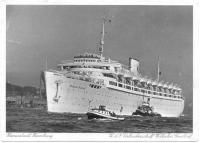 Seventy years ago today, on January 30, 1945, the German passenger liner MV Wilhelm Gustloff sank in the Baltic after being struck by three torpedoes from a Soviet submarine. An estimated 9,400 died in the sinking, making it the largest loss of life of any maritime disaster.
Seventy years ago today, on January 30, 1945, the German passenger liner MV Wilhelm Gustloff sank in the Baltic after being struck by three torpedoes from a Soviet submarine. An estimated 9,400 died in the sinking, making it the largest loss of life of any maritime disaster.
The ship, which was designed to carry a maximum 1,800 passengers and crew, was crammed with more than 10,000 people. In addition to the crew of 173, something over 1,500 were German soldiers fleeing the Russian advance on Gdynia. Almost 9,000 passengers were civilians, including an estimated 5,000 children.
The Wilhelm Gustloff was part of the German Navy’s Operation Hannibal an evacuation of German troops and civilians in the last days of World War II. Between 800,000 and 900,000 refugees and 350,000 German soldiers were evacuated across the Baltic Sea to Germany and German-occupied Denmark.

Tommy Thompson’s two years on the run has come to an end. He was arrested yesterday in a Palm Beach, Florida hotel. Thompson was arrested along with his longtime companion, Alison Anteiker.
In September, we posted about the continued recovery of gold, jewelry and other valuable artifacts from the wreck of the steamer SSCentral America which sank in 1857. Known as “the Ship of Gold,” the wreck of the ship believed to be carrying between 3 and 21 tons of gold from the California gold rush, was discovered by the Columbus-America Discovery Group, led by Tommy Thompson, after a decade long search. Thompson was sued by his investors in 2005, when they did not receive promised returns from the over $100 million of cargo recovered in the initial salvage. Thompson went into hiding in 2012 and has been sought by US Marshalls on outstanding warrants. Notwithstanding his legal and financial problems, Thompson is recognized as a gifted engineer who pioneered many modern techniques in underwater salvage.
A video shot and edited by Dave Elsmo about the Deuce, the world’s largest iceboat, on Lake Mendota, in Madison, WI during the Wisconsin Stern Steerers Association Regatta. The 54′ stern-steerer speed demon built in the 1930s and rebuilt in 2006 is said to have a top recorded speed of 104 mph (90 knots.)
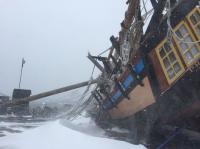
Photo: Rocky Steeves
The sloop Providence, a 1976 built replica of the Continental Navy sloop of the same name, was blown off her jack stands while on shore at Newport Shipyard in Newport, Rhode Island on Tuesday in blizzard conditions. The ship was dis-masted and suffered hull damage when she fell over in winds reported to be gusting up to 60 mph. Thorpe Leeson, the sloop’s owner, told the Associated Press that extra supports were added beneath the ship as a precaution for the storm, but they failed in the high winds.
The Providence is a replica of a Continental Navy sloop built in 1775 and which was commanded by Abraham Whipple, John Paul Jones and John Rathbun, among others. The Providence sank or captured 40 British ships during the war. The replica Providence is 61′ long on deck and 110′ long overall and has a fiberglass hull. She has appeared in a variety of roles in several movies including two of the Pirates of the Caribbean films.
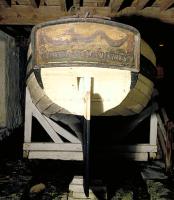
Peggy of Castletown
Peggy, the oldest yacht in the UK and the oldest schooner in the world, is being restored. Sometime between 1786 and 1791, George Quayle of Castletown, on the Isle of Man, had a shallop built, which he named Peggy. A shallop is a light sailboat built for coastal fishing, as a tender, or in the case of Peggy, as a pleasure craft. According to National Historic Ships UK, she may have worked as as a cargo vessel in the Irish Sea and around Liverpool sometime between 1791-1835. There is also evidence that she may have been armed with six cannon and two stern chasers. The shallop was also fitted with sliding keels.
Following George’s Quayle death in 1835, Peggy was put in storage in a subterranean boat shed and was largely forgotten about. One hundred years later, Emily Quayle bequeathed Peggy and the boat shed to the Isle of Man.

Graphic: Weather.com
A major blizzard is heading for the US Northeast coast today. It has been given the name Winter Storm Juno. If the prediction models are accurate, Juno may set a new record for snowfall in metropolitan New York City. So, it seems a good time to ask the question, “When is a blizzard like a hurricane?” The answer is, “when a blizzard bombs out in the Gulf Stream.”
Now, what does that mean? Juno is expected to “bomb out,” which is meteorological short-hand for achieving “bombogenesis.” That doesn’t do much to clear things up, either. Bombogenesis sounds like something from a bad science fiction movie. Bombogenisis refers to a rapid drop in the barometric pressure in a cyclodal storm of 24 millibars in a 24 hour period. This still doesn’t answer the question but we are getting closer. The sudden drop in pressure causes a major intensification of the storm, which is why Juno may drop record setting amounts of snow and generate hurricane force winds.
A fascinating video of dolphins and whales creating and then playing with bubble rings — toroidal vortices, also known as vortex rings. (Also a bit of volcanoes blowing smoke rings.)
 This May will be the 250th anniversary of the launching of HMS Victory, the 104-gun first-rate Royal Navy ship of the line best known as Lord Nelson’s flagship at the Battle of Trafalgar in 1805. HMS Victory was also Keppel’s flagship at Ushant in 1778, Howe’s flagship at Cape Spartel in 1782 and Jervis’s flagship at Cape St Vincent in 1797. Since 1922, the ship has been in No. 2 dock at Portsmouth, UK. Four years ago, a maintenance report concluded that the historic ship was riddled with rot and being pulled apart by its own weight. Since then, the problems have persisted.
This May will be the 250th anniversary of the launching of HMS Victory, the 104-gun first-rate Royal Navy ship of the line best known as Lord Nelson’s flagship at the Battle of Trafalgar in 1805. HMS Victory was also Keppel’s flagship at Ushant in 1778, Howe’s flagship at Cape Spartel in 1782 and Jervis’s flagship at Cape St Vincent in 1797. Since 1922, the ship has been in No. 2 dock at Portsmouth, UK. Four years ago, a maintenance report concluded that the historic ship was riddled with rot and being pulled apart by its own weight. Since then, the problems have persisted.
This week, the BBC reported that HMS Victory is ‘slowly rotting away from the inside’. Continue reading
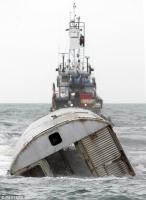
Photo: Stephen Mallon
Redbird Reef lies sixteen miles out in the Atlantic Ocean from the Indian River inlet, near the ominously named Slaughter Beach, Delaware. One of three explanations for the town’s name is that the first postmaster was William Slaughter. Likewise, while many reefs are named after ships that ran up on them, that is not the case with Redbird, which is an artificial reef in around 80 feet of water. The reef is named after the 714 New York City Redbird subway cars that, starting in 2001, were dumped on the generally barren sandy bottom. The cars became home to sponges, blue mussels, sea grasses, as well as flounder, tautog, and black sea bass. The cars were built of steel and painted red, earning their nickname, Redbird. Before dumping, the cars were cleaned of oil and grease and the doors and windows are removed.
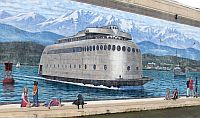
Mural in Port Angeles, Washington
The ferry MV Kalaka is making its last voyage today, a short trip to the scrap yard. The 276′ ferry carried millions of cars in the Puget Sound between Seattle and Bremerton between 1935 and 1967 and was notable for her streamlined form, art deco styling and luxurious amenities. After more than thirty years of service, she was decommissioned and towed to Alaska to be used as a crab and fish processor at Dutch Harbor and Kodiak. She was returned to the Seattle area in 1998 but despite the efforts of various owners with a range of restoration plans, the ship became a derelict. MV Kalaka will be towed roughly a mile from a dock on the Hylebos Waterway, where she has been moored for a decade, to a graving dock on the Blair Waterway, where she will be scrapped.
 New York harbor has lost part of its living history with the passing of Sal Polisi, longtime volunteer and master carver at the South Street Seaport Museum. For three decades, Polisi carved everything from figureheads to wooden signs, using the time honored methods of a master craftsman. All his work was done by hand, without power tools or computers. Beyond his remarkable skills, he also a friendly face at the museum and was well loved by all who knew him. He will be sorely missed.
New York harbor has lost part of its living history with the passing of Sal Polisi, longtime volunteer and master carver at the South Street Seaport Museum. For three decades, Polisi carved everything from figureheads to wooden signs, using the time honored methods of a master craftsman. All his work was done by hand, without power tools or computers. Beyond his remarkable skills, he also a friendly face at the museum and was well loved by all who knew him. He will be sorely missed.
From South Street Seaport president, Captain Jonathan Boulware:
It is with a heavy heart that we mark the passing of our own Sal Polisi, master woodcarver, Seaport stalwart for well over thirty years, and gentleman of few peers.
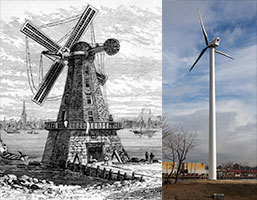
Edge’s Windmill, 1815 — Sim’s Wind turbine 2015
Recently, the NY Times and others have been reporting on the installation of the first commercial wind turbine in New York City. The Sims Municipal Recycling facility in Sunset Park on the Brooklyn waterfront has installed a 100 KW 160′ tall wind turbine. Wind power is expected to provide about 4% of the electricity for the recycling plant, while solar panels on the facility roof already provide approximately 16% of the plant’s electrical needs.
While the new Sims’ turbine is the first in New York City, it is certainly not the first in the harbor. Just across the water, an even larger wind turbine has been in operation on the Bayonne waterfront for the last three years. The Bayonne Municipal Utilities Authority’s wind turbine has a rated capacity of 1.5 MW and stands 262′ tall.
Wind power, however, has at least a two hundred year history in New York harbor. Continue reading

Rokudenashiko in her vagina boat
Last May, Japanese artist Megumi Igarashi posted on her blog, Maybe you were thinking, “Hey, what happened to that vagina boat?” Well, good news: The vagina boat finally set sail. (Honestly, the question hadn’t crossed my mind.)
Igarashi, who goes by the nickname Rokudenashiko (“the good for nothing girl”), had raised money through crowd-sourcing to fabricate a 3D printed plastic model of her vagina to be installed on a roto-mold kayak. From the photos, my only issue with the kayak is that there is no place to put on a spray skirt. The Japanese authorities had other concerns.
The Norwegian firm Lade AS is developing a hybrid ship design, Vindskip, in which the ship sails using lift off its airfoil shaped hull. It is an intriguing design. Nevertheless, I can’t quite figure out how it would work in practice. It appears that since the hull itself is acting as the “sail” the only way to trim the “sail” for differing wind conditions is to change course in relation to the wind. Perhaps I am missing something.
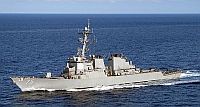
USS Donald Cook
At 1 p.m. on Friday, the breaking news on the New York Post and the United Press Twitter feeds was that the Chinese had attacked US naval ships with missiles and that the “US Navy was engaged in active combat with Chinese vessels in the South China Sea.” The UPI Twitter feed also reported naval combat and also featured a photo of Pope Francis with the quote, “World War II has begun.” None of it was true. The Twitter feeds had been hacked. By now it should not be breaking news that one should never necessarily take anything in the Internet at face value.
That being said there is a very interesting story floating around the net about an incident last April in which the Arleigh Burke-class guided missile destroyer USS Donald Cook was “buzzed” by a Russian SU-24 fighter jet. The fighter made 12 “close-range, low-altitude” passes near the Cook while the ship was in international waters in the western Black Sea near Romania, Pentagon spokesman Col. Steve Warren told reporters. The fighter was observed to be unarmed. A second unarmed SU-24 fighter jet was also observed in the area.

. …………………………………. “Fat Leonard” Glen Francis
In October 2013, we posted that a US Navy purchasing scandal sounded like a bad novel. Bribes, prostitutes, and Lady Gaga tickets were allegedly handed out to US Navy officers by a Malaysian businessman in exchange for classified information and directing business toward the Singapore-based contractor, Glenn Defense Marine Asia (GDMA.) GMDA was accused of overcharging the Navy tens of millions of dollars for port services.
The drama is not over, but it is winding down. Leonard Glenn Francis, known is military circles as “Fat Leonard,” pleaded guilty to bribery and conspiracy charges in federal court Thursday. Francis, chief executive of GDMA, faces up to 25 years in prison and will forfeit $35 million to the US government, according to the plea agreement.
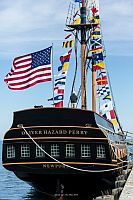 It doesn’t feel very much like summer right now, but at least we are on the far side of the winter solstice, so each day brings spring a bit closer. And this spring, the Oliver Hazard Perry, the first ocean-going full-rigged ship to be built in America in over a century will begin sailing. The OHPRI organization has announced summer camp programs on the new sailing school ship. From their press release:
It doesn’t feel very much like summer right now, but at least we are on the far side of the winter solstice, so each day brings spring a bit closer. And this spring, the Oliver Hazard Perry, the first ocean-going full-rigged ship to be built in America in over a century will begin sailing. The OHPRI organization has announced summer camp programs on the new sailing school ship. From their press release:
Teens from around the country and the world will board in July and August for thrilling one- and two-week Education at Sea camps. The 200-foot Sailing School Vessel (SSV) Oliver Hazard Perry, hailing from Newport, R.I., has a 500-ton steel hull and a 130-foot tall rig with square sails on all three masts. She will have a captain, officers, a cook, an engineer and a dozen other professional crew members, but the balance of her crew will be none other than the students themselves – after all, she is a Sailing School Vessel.
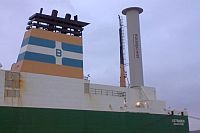 We have followed the E-Ship 1 for the last four years. The ship is a Ro/Lo cargo ship owned by the world’s third-largest wind turbine manufacturer, Germany’s Enercon GmbH and is distinctive because it is fitted with four Flettner rotors. The rotors are vertical cylinders which spin and develop lift due to the Magnus effect as wind blows across them. So far, Enercon reports that they are observing roughly 25% fuel savings due to the rotor sails.
We have followed the E-Ship 1 for the last four years. The ship is a Ro/Lo cargo ship owned by the world’s third-largest wind turbine manufacturer, Germany’s Enercon GmbH and is distinctive because it is fitted with four Flettner rotors. The rotors are vertical cylinders which spin and develop lift due to the Magnus effect as wind blows across them. So far, Enercon reports that they are observing roughly 25% fuel savings due to the rotor sails.
In December, the Finnish shipping line Bore installed a single rotor on the ro/ro M/V Estraden. The installation is an updated version of the Flettner rotor featuring advanced materials and a leading-edge control system designed and built by the Finnish marine engineering company Norsepower Oy Ltd. The ship will be undergoing testing of the new rotor sail auxiliary over the next several months.
The basic design of the Flettner rotor has been around for over 90 years. Flettner applied for his patent on the design in 1922. The Flettner rotor ship Buckau set sail in 1925, first crossing the North Sea and then the Atlantic.
Last Wednesday, Rob Konrad went fishing alone in his 36 foot Grady White boat. He left Deerfield Beach, FL and headed about nine miles out in the Atlantic Ocean. At about 1PM, with the boat trolling at about 5 knots on autopilot, Konrad fell overboard when struck by a wave while attempting to reel in a large fish. He was not wearing a flotation device and could only watch as his boat headed east toward the Bahamas. Remarkably, over the next 16 hours, Konrad swam the nine miles to shore, managing to crawl ashore on Palm Beach at 4:30 a.m. on Thursday. Konrad was taken to a local hospital, where he said he was treated for hypothermia and severe dehydration. He told his story at a press conference yesterday and appeared to be in good condition given his ordeal. Konrad was a professional football player from 1999–2004. The team he played for? The Miami Dolphins. Fortunately for all concerned, Konrad swims like one. Thanks to Irwin Bryan for contributing to this post.
